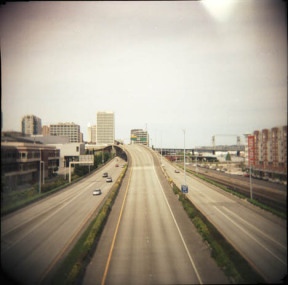If downtown development, real estate, City Hall, arts, and local media in Tacoma spark your interests, then youre probably familiar with Exit133.com. Derek Young — Tacoma resident since 1992, and University of Puget Sound alum — runs the blog (which refers to the I-5 exit for Tacoma) from his North Slope home. The goal? Create a positive, online community where fellow Tacomans can weigh in on issues facing a city in the middle of a development boom (rumors of a grocery store opening downtown created big-time buzz on the site last week; an interactive, downtown condo map keeps tabs on the citys growth), meet up for regular Thursday night lawn games in Wright Park, and snap photos of the city for a year-long, Exit133.com project called Tacoma 365.
I recently met Young, 32, at the bar at Tacoma Wine Merchants to discuss his site, the city, and why he chooses to live in Tacoma.
TODD MATTHEWS: How did you come up with the idea for Exit133.com?
DEREK YOUNG: Originally, it was a personal thing. It was a way to keep family and friends updated. On the side, I was learning all sorts of things about the city. I was just trying to find a place to kind of put some of it out there for a larger audience - especially when I found something really interesting. So I went looking for Tacoma blogs. I couldnt find anything so I started Exit133.com. If I heard something or saw something if it seemed interesting, I would put it online. If I did something that seemed vaguely interesting, I would put it online. It was an experiment. One of the things that kind of got me in the early days of the site is the challenge of reading about the news in Tacoma. We are a shadow city. The primary news sources are dominated by another citys news market. Generally, what you discovered was the only news that trickled out was negative. You cant get a positive, human-interest or development story in Tacoma to trickle up in the media. Regionally, we werent getting a lot of attention. You have to filter through seven negative stories for every two or three positive stories. One of the things I did very early on was to say I was going to have a positive editorial position. What are the good things going on down here? I was going to try and keep things upbeat.
MATTHEWS: It really seems to be a place for tips and discussion on development in the city. Is that an interest of yours?
YOUNG: Its a very strong interest of mine. Now, I live in an 1880s house. Im not looking to move into a downtown condo right now. I love them. I think they are tremendous. But my dog would hate it.
MATTHEWS: Do you think the development boom right now is overhyped?
YOUNG: Im not concerned about overhype. I may be worried about the condos in the $500,000-plus market. That just seems to be an insane price point. My bigger concern is a lack of mixed-use. You have destination retail and destination restaurants downtown. You have a pocket of one, two, or three places, and then theres nothing. And then theres a pocket of one, two, or three. Theres no real good way to walk across downtown. Thats a bigger concern to me than the condos. I wish they were growing taller and putting more mixed-use down below them. I dont like the idea that I have to drive from point-to-point. I wish there were areas I could literally park and walk and find something to eat without knowing the absolute destination ahead of time. Its not that easy.
MATTHEWS: Your blog seems to be more about putting ideas out there and asking, What do you think? Whereas other blogs seem to be more focused on the opinions of a single person.
YOUNG: Im just trying to get people to talk other than the voices you have always heard. Im trying to get more people to chime in and put something out there. There are a lot of other people who know a lot more about this than me. Im covering a lot of areas. I dont know much about zoning laws. Im not an urban planner. Ill toss my opinion in there, but Im putting it out there for other people to put their two cents in. Im looking to promote discussion. Other people are a lot more learned than I am on these topics.
MATTHEWS: I find it funny that your Web site reads, In Tacoma by choice. Do you find yourself explaining to people outside of the city why you live here?
YOUNG: I dont explain as much as I used to. It was more defensive before. Now its a confidence thing. I live in Tacoma. Period. Done. You dont explain anything. I choose to live here. I work halfway between here and Seattle. Ninety percent of my office lives in Seattle or up north. I said, No. I want to be down here. Early on, it was a cost-of-living lifestyle choice. I had a nice apartment in a great neighborhood. I could park in front of my house unlike my friends in Seattle. Over time, I became more attached. This is my community. This is where I live.
MATTHEWS: Do you think the citys development plans downtown and along the Foss waterfront — will come to fruition?
YOUNG: Im not sure. Whats the goal? If the goal is higher property values, that will happen. If the goal is community, I dont see it yet. If you look at the citys plan and zoning, theres very little guidance as to what is getting built. Were not seeing things that are actually going to help get people outside of their condos. Im curious about where were headed. There are streets in Bellevue and Belltown that are very nice, but you walk around them at night, and they are dead. I have a fear thats what downtown Tacoma will become. You know, where you have a nice restaurant on one block, and then condo block after condo block. I dont see that as a good thing. Others do. Ive gotten into very vocal debates with people about that. I want to see a lively downtown that we can go to. A destination downtown for the whole city to enjoy. I dont want it to be just a place for people to buy fancy condos and work downtown. A bigger issue to me is the inability to actually have a big business downtown. There is a shortage of Class A commercial real estate. If a major company wanted to come down here, trying to find a place for 60-plus employees would be nearly impossible. Without that, you lose a big segment of people that are in their key moneymaking years. People who are in their 30s or 40s who work at a large company. There are very few places I can work downtown. There are very few places my friends can work downtown. Were all commuters. We all go elsewhere. Other than, say, Russell Investment, theres nobody thats going to be able to use our skills. Thats a problem and I dont see any solution on the horizon.
MATTHEWS: What was the thinking behind Tacoma 365?
YOUNG: That was an early experiment in getting other people involved. Its interesting. Contributing photographers have kind of come and gone. I didnt want it to be an artsy thing. It was more about images. I wanted it to be random, as long as the compositions were nice and interesting.
MATTHEWS: Do you think the photographs describe the city?
YOUNG: Its hard to say. It describes what I see, but Im not necessarily normal. It describes the city at a different level. I dont want to take a picture of the building. I want to take a picture of a detail in the corner of the building. At that point, youre kind of getting away from the city and getting down to the grains of it. Whats amazing to me is I get a lot of e-mails from people who dont live here anymore but love the photos. They moved away and read the site to keep up with whats going on in the city. The photo is something they look forward to everyday.
MATTHEWS: What are your thoughts on the idea of developing a streetcar in Tacoma?
YOUNG: I like it. I love it. I dont want to have to drive so much. I see it as a great way to come and go. It seems a lot sexier than the bus. When its all said and done, it may not pencil out. But I believe we need something to get people out of their cars.
MATTHEWS: What should happen to the Winthrop Hotel?
YOUNG: In my world, I want it to go market rate. A hotel is fine. I dont know how it would do. Im not saying get rid of low-income housing downtown. My concern is that downtowns low income housing is all concentrated in one part of the city. If you are going to have low-income in downtown, have a plan for it. Have a better idea than, Well, theyre there now. Lets keep them there. Locking it into a multi-decade plan of being low-income because were too lazy or cheap to find an answer now isnt good strategic thinking.
MATTHEWS: What are your thoughts on the recent bond failures for Tacoma Dome, and the citys decision this year to loan $2.7 million to make improvements to the Dome?
YOUNG: Im still waiting for them to tell me what [the Dome is] doing for us. I havent been to the Dome in I dont know how many years. I would rather see investments in the area around the Dome. Youre starting to see it. But my issue with the Dome bond was that they never said what was in it for Tacoma. Why would it be interesting to me to support it through my money? I never heard that other than its an icon of our history and success. Im sorry. Things change. Its an area I dont visit often, other than the parking lot. I would rather see improvements to the look of Tacoma from the freeway. Level the Dome and make it a green space.
— SIDEBAR ARTICLE —
Interested in following Tacoma through the blogosphere? Check out these sites:
Exit133.com
http://www.exit133.com
Thrice All-American
http://www.thriceallamerican.com
Tacomaness
http://www.tacomaness.com
KevinFreitas.net
http://www.kevinfreitas.net








